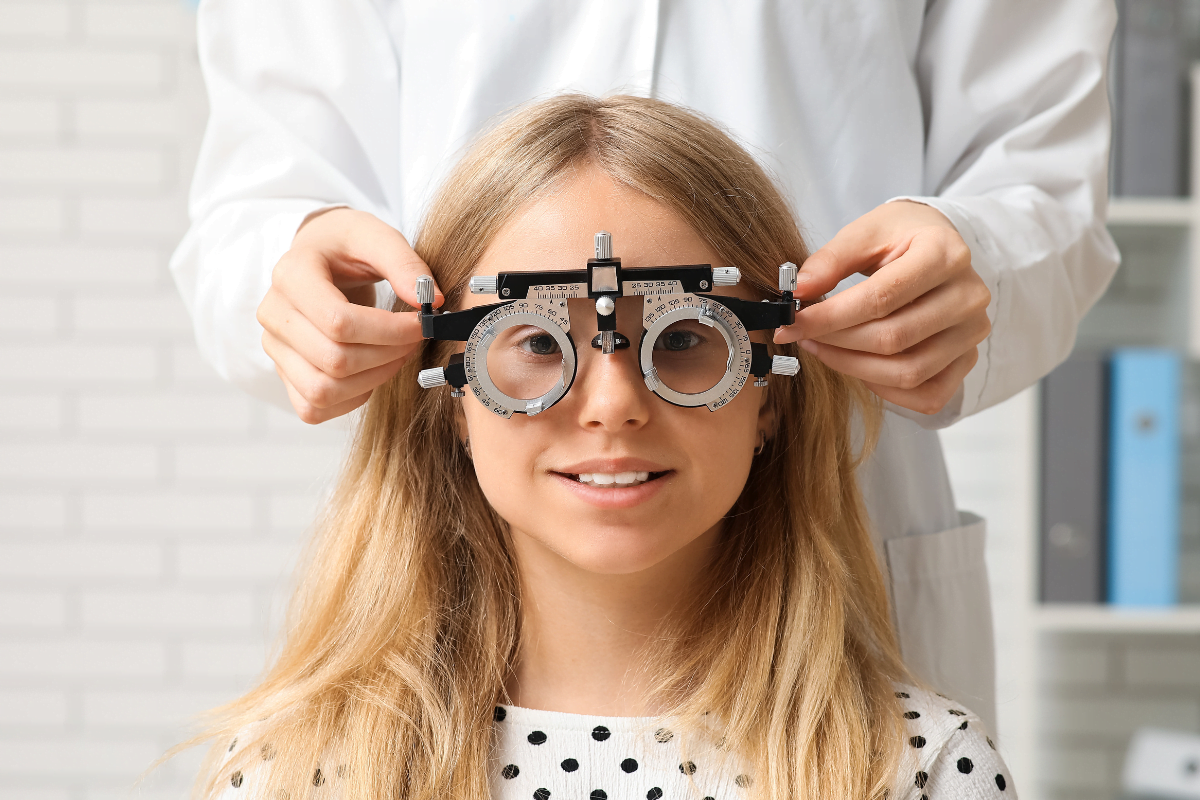Every August, we observe Children’s Eye Health and Safety Month, a crucial time to raise awareness about the importance of protecting children’s vision. Eye health is vital for a child’s development, as good vision plays a key role in their learning and overall well-being. This month is dedicated to educating parents, caregivers, and communities about the steps they can take to ensure children’s eyes are healthy and safe!
The Importance of Regular Eye Exams
One of the primary focuses of Eye Health and Safety Month is encouraging parents to schedule regular eye exams for their children. These exams are essential for detecting vision problems early, which can significantly impact a child’s academic performance and daily life. Conditions like nearsightedness, farsightedness, and astigmatism can often go unnoticed without proper screening.
Common Eye Problems in Children
Children can experience various eye issues, some of which include:
Amblyopia (Lazy Eye)
Amblyopia, or typically known as lazy eye, happens when one eye is weaker than the other. This condition develops in early childhood and can later lead to vision problems if not treated promptly. In this condition, the brain favors one eye over the other, which can result in poor visual development in the affected eye. Treatment can include patching the stronger eye to encourage the weaker one to work harder, vision therapy, or corrective glasses.
Strabismus (Crossed Eyes)
Strabismus, popularly known as crossed eyes, is characterized by a misalignment of the eyes. In such a condition, one eye may turn inward, outward, upward, or downward while the other eye looks straight ahead. This condition can affect depth perception and coordination, making it difficult for children to judge distances as well as do tasks that require precise hand-eye coordination.
Refractive Errors
Refractive errors are vision issues caused by the eye shape, preventing light from focusing correctly on the retina. Common refractive errors include nearsightedness (myopia), where distant objects appear blurry; farsightedness (hyperopia), where close objects are blurry; and astigmatism, which causes overall blurred vision due to an irregularly shaped cornea. However, these conditions can now be corrected with prescription glasses or contact lenses. In some instances, refractive surgery may be an option for older children and adults.
Caring for Your Eyes: Tips for Eye Safety Month
During Children’s Eye Health and Safety Month, it’s crucial to highlight ways to prevent eye injuries and promote eye safety. Here are some tips:
Use Protective Eyewear
Ensure children wear protective eyewear when getting involved in sports or activities that may risk their eyes. It is especially crucial in contact sports, where accidental collisions or impacts are common and can cause serious eye injuries. Hence, proper eyewear is necessary to significantly reduce the risk of trauma and ensure safer play.
Responsible Screen Time
Excessive or prolonged screen time can lead to eye strain and other vision problems. Encourage regular breaks and outdoor play to reduce the risk of digital eye strain and support overall eye health. Additionally, practicing the 20-20-20 rule, or taking a 20-second break to look at something that is 20 feet away every 20 minutes, can help alleviate digital eye strain.
Provide a Balanced Diet
Nutrients like vitamins A, C, and E, along with omega-3 fatty acids, are essential for maintaining good eye health. Include a wide variety of dishes that have fruits and vegetables in your young one’s diet to ensure that they receive a broad spectrum of essential nutrients that support visual function and protect against eye diseases.
Educate About Eye Safety
Teach children the importance of not rubbing their eyes with dirty hands and the dangers of sharp objects. Explain that even small objects can cause significant harm if they come into contact with the eyes, and encourage them to use appropriate safety gear when participating in activities that involve potential hazards.
Early Detection and Intervention
Detecting eye problems early can prevent long-term vision issues. It is important to note that parents should be aware of signs that might indicate a problem, such as squinting, sitting too close to the TV, or complaining of headaches. If any of these signs are present, it’s critical to schedule an eye exam as soon as possible.
Takeaways
This Children’s Eye Health and Safety Month, it is important to prioritize our children’s vision. By taking proactive steps during eye health month, we can ensure our children have the best possible start in life with healthy and protected eyes. Encourage regular eye exams, practice eye safety, and educate on the importance of good vision to contribute to your child’s overall health and success.
Frequently Asked Questions (FAQs)
At what age should children have their first eye exam?
It is recommended that children have their first eye exam between the ages of 6 months up to their first year. Eye exams during this stage can help identify any vision issues or eye health concerns early on. Regular eye exams should continue throughout childhood, with follow-ups as recommended by an eye care professional.
How can excessive screen time affect a child’s vision?
Prolonged use of electronic devices such as phones, computers, and TV can cause digital eye strain, which may trigger symptoms such as dry eyes, blurred vision, and headaches. Excessive use of these devices can also contribute to poor posture and a decreased focus on tasks, potentially affecting a child’s overall eye health. Balancing screen time with breaks and outdoor activities can help mitigate these effects.
What are some common misconceptions about children’s eye health?
One common misconception is that vision problems are rare in young children. In reality, many children have undiagnosed vision issues that can affect their learning and development. Another misconception is that if a child seems to see well, they don’t need an eye exam. Regular eye exams are essential because some vision problems may not be noticeable to parents or the child.

